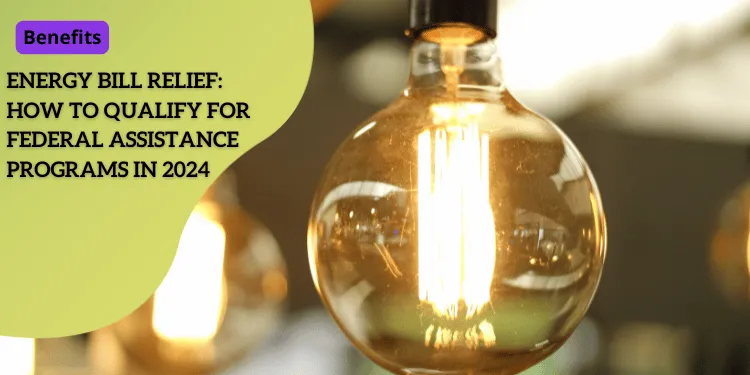Energy Bill Relief: How to Qualify for Federal Assistance Programs in 2024

The Low Income Home Energy Assistance Program (LIHEAP) and the Weatherization Assistance Program (WAP) are the cornerstone federal programs designed to help low-income households manage their energy costs.
Understanding how these programs work and their differences can significantly affect the well-being of those struggling with high energy bills.
Overview of LIHEAP and WAP
LIHEAP provides financial aid to help pay for heating and cooling bills.
It’s targeted at easing the burden of energy costs for low-income families, especially during peak winter or summer months.
Those who qualify can receive assistance to cover their utility bills or emergency services during an energy crisis.
On the other hand, WAP focuses on improving the energy efficiency of the homes of low-income families, thereby reducing their overall energy consumption.
This program provides for various home improvements like insulation, fixing or replacing heating systems, and addressing other energy-wasting issues.
Key Differences Between Heating/Cooling Bill Assistance and Weatherization Support
LIHEAP and WAP serve different but complementary roles.
LIHEAP offers immediate financial relief for energy bills, crucial during extreme weather conditions when heating and cooling become necessary.
It’s more about keeping the power on and maintaining a stable living environment.
WAP looks at the long-term picture by investing in home improvements.
These efforts can significantly reduce future energy bills by making homes more energy-efficient.
So, while LIHEAP addresses the immediate financial struggle, WAP aims to lessen the energy burden over time through sustainable solutions.
Importance of These Programs for Low-Income Households
These programs are incredibly important for low-income households.
High energy bills can eat into a significant portion of their limited incomes, making it difficult to afford other necessities like food, healthcare, and education.
LIHEAP ensures that such families can keep their homes adequately heated or cooled without sacrificing other essential needs.
Meanwhile, WAP’s enhancements can lower energy bills permanently, providing a lasting solution to energy poverty.
Both initiatives ensure that vulnerable populations don’t have to choose between paying their energy bills and other crucial expenses, thereby improving their overall quality of life.
Understanding the distinct roles of LIHEAP and WAP is essential.
This knowledge empowers individuals to access appropriate assistance, ensuring that they can manage their energy needs effectively and sustainably.
This overview sets the stage for more detailed discussions on eligibility criteria, assistance types, and application processes that can help those in need navigate these vital programs.
LIHEAP Eligibility and Benefits
Income-based Qualification Criteria for LIHEAP
To qualify for the Low Income Home Energy Assistance Program (LIHEAP), your household income must fall below a certain threshold, which is defined by your state but is generally based on federal poverty guidelines.
Typically, the income limit is set at or below 150% of the federal poverty level or 60% of the state median income, whichever is higher. Here’s a simplified breakdown of the common criteria:
| Eligibility Factor | Details |
|---|---|
| Household Size | Larger households may qualify with higher income thresholds |
| Income | State-specific income limits; check with your state’s LIHEAP office |
| Proof of Income | Required documentation may include pay stubs, tax returns, or benefits statements |
It’s crucial to know that eligibility and benefits can vary significantly by state, so you’re encouraged to contact your local LIHEAP office for detailed criteria.
Types of Assistance Available
LIHEAP offers various kinds of financial help to ensure households maintain heating and cooling throughout the year.
The main types of assistance include:
- 💡Heating Bills: Assistance to cover heating expenses during colder months.
- 💡Cooling Bills: Support to offset air conditioning costs in warmer months.
- 💡Emergency Services: Aid during energy crises, such as imminent utility shutoffs or lack of fuel.
- 💡Weatherization Support: Although LIHEAP primarily focuses on bill assistance, it occasionally offers support for basic weatherization to improve energy efficiency.
These programs are designed to alleviate the financial burden on low-income families, helping them manage their energy costs more effectively.
How to Contact State LIHEAP Office for Application
Applying for LIHEAP starts with reaching out to your respective state office, as each state has its own process and requirements.
Here’s a simple guide to get started:
- Locate Your State Office: Find contact information through the U.S. Department of Health and Human Services, which lists state LIHEAP offices.
- Gather Documentation: Prepare needed documents such as proof of income, utility bills, and identification.
- Submit Application: Fill out the necessary forms, which can often be done online, in person, or via mail, depending on your state’s procedures.
These steps are essential to ensure a smooth application process and timely receipt of benefits.
Transitioning from understanding LIHEAP to applying for it is straightforward but requires attention to your state’s specific requirements.
Weatherization Assistance Program (WAP)
With energy costs on the rise, the Weatherization Assistance Program (WAP) can help you make your home more energy-efficient and lower your bills.
This program focuses on making lasting improvements to your home’s energy performance, which benefits low-income households the most.
Qualification Criteria for WAP
To qualify for WAP, your household must meet certain income requirements.
Generally, your income must not exceed 200% of the federal poverty level.
However, another route to qualify is if you are already receiving benefits from federal assistance programs such as Temporary Assistance for Needy Families (TANF) or Supplemental Security Income (SSI).
These existing benefits automatically make you eligible for WAP, streamlining the qualification process.
Types of Home Improvements Covered
WAP provides a range of home improvements aimed at enhancing energy efficiency.
Here are some of the key types:
- 💡Insulation: Adding insulation to walls, attics, and floors to reduce heat transfer and improve heat retention.
- 💡Air Sealing: Sealing leaks around doors, windows, and other openings to prevent drafts and minimize wasted energy.
- 💡HVAC Systems: Repairing or replacing inefficient heating and cooling systems to improve performance and reduce energy usage.
- 💡Energy-Efficient Lighting: Installing compact fluorescent or LED lighting to replace older, less efficient bulbs.
- 💡Window Treatments: Adding storm windows or other treatments to minimize heat loss.
These improvements not only lower energy bills but also make homes healthier and more comfortable by maintaining consistent indoor temperatures.
Application Process through State WAP Offices
Applying for WAP starts with contacting your state’s WAP office.
Here’s a simplified process to guide you:
- Reach Out: Contact your state WAP office to express interest and get detailed information about the program.
- Eligibility Verification: Provide necessary documentation to prove your income level or your participation in TANF or SSI.
- Home Assessment: A professional energy auditor will inspect your home to identify the most effective energy-saving measures.
- Implementation: Approved contractors will carry out the energy efficiency improvements recommended by the auditor.
By following these steps, you can avail of significant fiscal and comfort benefits, making your home more energy-efficient and sustainable.
Utility Disconnection Policies
State-Specific Regulations
Utility disconnection policies vary widely across states in the U.S. Each state sets its own rules concerning when utility companies can disconnect services like electricity and natural gas due to non-payment.
It’s crucial for residents to understand their state’s specific regulations to avoid unexpected disruptions, especially during critical times.
Factors leading to variations in disconnection policies include:
- 💡Weather Conditions: In many states, utility companies may be barred from disconnecting services during extreme weather conditions. This means your services won’t be shut off during a heatwave or a severe winter storm, ensuring safety and health during these critical periods.
- 💡Age: Some states have protections for elderly residents, preventing disconnection if a household member is above a certain age, usually 65 or older.
- 💡Disability Status: Policies also often include provisions for people with disabilities, safeguarding them from disconnection due to non-payment.
Understanding these rules can help you navigate and abide by state-specific guidelines to ensure your utilities remain uninterrupted.
Factors Affecting Disconnection Policies
Several factors influence whether and when a utility service can be disconnected:
- Weather: Most states have statutes or regulations that prevent utilities from being disconnected during extreme weather. This can include hot summers or cold winters, where maintaining a climate-controlled environment is essential for health and safety.
- Age Restrictions: States often protect elderly residents from utility disconnection. If you or a household member is a senior, you might be exempt from service cutoffs during standard payments lapses.
- Disability Status: Households with members who have disabilities may also receive protections under utility disconnection regulations. States recognize the increased vulnerability of this group and often provide additional safeguards to prevent service interruptions.
Variation in Policies by Utility Provider
It’s also important to recognize that policies can differ based on the utility provider.
Some companies might have more lenient policies than others, offering extended payment plans, or alternative forms of assistance in lieu of immediate disconnection.
Therefore, always check with your specific utility provider to understand:
- 💡Payment Plan Options: Many utilities offer budget billing or deferred payment plans to assist customers in managing their bills throughout the year.
- 💡Grace Periods: Some providers extend grace periods beyond the typical state mandates, allowing additional time for bill payment before disconnection.
- 💡Assistance Programs: Utility providers often have their assistance funds or programs for those struggling to pay bills, which can be a critical resource in avoiding disconnection.
Navigating utility disconnection policies provides a safety net for vulnerable households.
Knowing your state’s specific rules, the factors affecting disconnection, and the variability among utility providers can be crucial.
Remember, utility services are vital, and keeping informed about these policies ensures you can take proactive steps to maintain them.
Next, we will explore the initial steps to determine your eligibility for assistance and the necessary documentation for applying to these lifesaving programs.
Getting Started with Assistance
Navigating the world of federal energy assistance programs might seem daunting, but by following a few clear steps, you can determine your eligibility, contact relevant state offices, and gather the necessary documentation for your application.
Steps to Determine Program Eligibility
The first step is to determine whether you qualify for federal assistance programs such as LIHEAP (Low Income Home Energy Assistance Program) or WAP (Weatherization Assistance Program).
Eligibility largely depends on your income level, but it may also be impacted by your participation in other federal assistance programs like TANF (Temporary Assistance for Needy Families) or SSI (Supplemental Security Income).
- Assess Your Income: Compare your household income to the federal poverty guidelines, as LIHEAP and WAP generally assist households at or below 200% of the federal poverty level.
- Check Additional Criteria: Review if there’s priority given based on age, disability, or the presence of young children in your household.
- Cross-Check State-Specific Requirements: Some states may add additional qualifications, so make sure to consult your state’s LIHEAP or WAP office for specific details.
How to Contact Relevant State Offices
Once you’ve assessed your eligibility, the next step is reaching out to the appropriate state office to begin your application process.
- Identify Your State Office: Every state has its own LIHEAP and WAP offices. You can typically find this information on your state’s Department of Health and Human Services website or by performing a quick online search.
- Get the Contact Details: Ensure you have the correct phone number, email, or physical address of the office. Many states provide hotlines or online portals for assistance.
- Reach Out: Call, email, or visit the state office online to inquire about the application process and any specific documents they might require.
What Documentation Might Be Needed for Application
Preparing the required documentation in advance can streamline your application process.
Here’s a list of commonly requested documents:
- 💡Proof of Income: Recent pay stubs, tax returns, or benefit award letters.
- 💡Identification: Government-issued ID, Social Security numbers for all household members.
- 💡Utility Bills: Copies of recent heating or cooling bills.
- 💡Proof of Residency: Lease agreements or mortgage statements.
By ensuring you have these documents ready, you can facilitate a smoother and quicker application process, getting you closer to securing the assistance you need.
These initial steps will help you navigate the application process more effectively, ensuring you gather all necessary information and documentation.
With your documents in hand and contact made with the relevant offices, you’re well on your way to accessing critical energy assistance.






